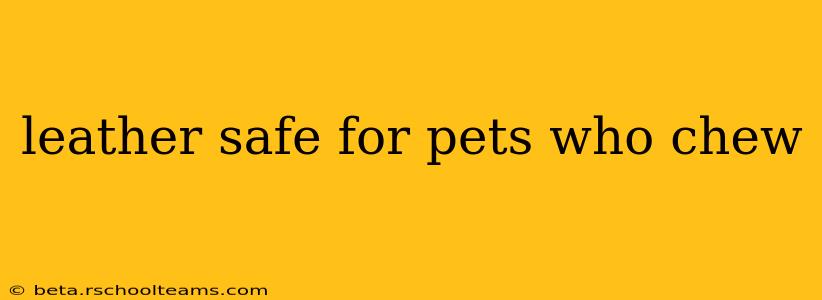Leather, with its luxurious texture and durability, is a popular choice for many household items. However, if you have a pet with a penchant for chewing, you might be wondering: is leather safe for them? The answer, unfortunately, isn't a simple yes or no. The safety of leather for your chewing pet depends on several factors, and understanding these is crucial for your pet's well-being.
What Happens When Pets Chew on Leather?
The immediate risk of a pet chewing on leather isn't usually toxic poisoning. The bigger concern is ingestion of leather pieces. Smaller pieces can cause gastrointestinal upset, leading to vomiting, diarrhea, and potentially blockage in the digestive tract. Larger pieces could cause more serious internal injuries. Furthermore, some leather products are treated with chemicals during the tanning process, and these chemicals could pose health risks if ingested.
Are There Different Types of Leather? Does It Matter?
Yes, absolutely! The type of leather and its treatment significantly impact its safety for pets. Full-grain leather, for example, is generally considered more durable and less likely to break down into small, ingestible pieces compared to cheaper, split-grain leathers. However, even full-grain leather isn't entirely risk-free. The tanning process, whether vegetable- or chrome-tanned, can involve chemicals that aren't ideal for pets to consume. It's impossible to guarantee the complete absence of harmful chemicals in any leather product.
What about Leather Furniture?
Leather furniture presents a particular challenge. While a strong, sturdy piece of furniture might be less likely to be damaged extensively by chewing, it still poses a risk. Small pieces can still be ingested, and the pet could potentially swallow larger pieces, leading to serious complications. The best approach with leather furniture and pets who chew is prevention. Providing appropriate chew toys and supervising your pet closely, particularly when they're near the furniture, is crucial.
What if my pet already chewed on leather?
If your pet has ingested some leather, monitor them closely for signs of distress like vomiting, diarrhea, lethargy, or loss of appetite. If you notice any of these symptoms, contact your veterinarian immediately.
What are some safe alternatives to leather for pets?
Durable, pet-safe materials such as tough nylon, canvas, or rubber are far better alternatives for chew toys and items within your pet's reach.
How can I protect my leather furniture from my chewing pet?
Prevention is key! This involves:
- Providing plenty of appropriate chew toys: Keep your pet occupied with safe and engaging chew toys to deter them from your furniture.
- Supervise your pet: Keep a close eye on your pet, especially when they're near your leather furniture.
- Use deterrents: Bitter apple spray or other pet-safe deterrents can make your leather furniture less appealing.
- Cover your furniture: Consider using furniture covers or throws to protect your leather furniture from chewing.
Conclusion: Leather and Chewing Pets – A Risky Combination
While a large piece of leather may not immediately pose a toxic threat, the risk of ingestion and potential gastrointestinal problems makes it unsafe for pets who have a habit of chewing. Prevention is the best strategy. Providing appropriate chew toys, supervising your pet, and using deterrents are essential steps to protecting both your pet and your leather goods. If your pet does ingest leather, seek veterinary advice immediately. Prioritize pet safety and opt for pet-friendly materials whenever possible.
